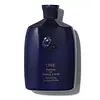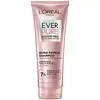What's inside
What's inside
 Key Ingredients
Key Ingredients

 Benefits
Benefits

 Concerns
Concerns

 Ingredients Side-by-side
Ingredients Side-by-side

Water
Skin ConditioningSodium Lauroyl Methyl Isethionate
CleansingSodium Cocoyl Isethionate
CleansingSodium Lauroyl Sarcosinate
CleansingCocamide Mipa
EmulsifyingDimethicone
EmollientPropanediol
SolventPolyglyceryl-3 Laurate
EmulsifyingParfum
MaskingAcrylates/Beheneth-25 Methacrylate Copolymer
Glycol Distearate
EmollientCoconut Acid
CleansingSodium Lauroamphoacetate
CleansingAmodimethicone
Pentylene Glycol
Skin ConditioningSodium Isethionate
CleansingGuar Hydroxypropyltrimonium Chloride
Skin ConditioningSorbeth-230 Tetraoleate
EmulsifyingCaprylyl Glycol
EmollientDivinyldimethicone/Dimethicone Copolymer
Hydroxyacetophenone
AntioxidantSodium Benzoate
MaskingTrisodium Ethylenediamine Disuccinate
Glycerin
HumectantPolyquaternium-7
Ethylhexylglycerin
Skin ConditioningDisodium EDTA
Decyl Glucoside
CleansingDimethiconol
EmollientPanthenol
Skin ConditioningLaureth-23
CleansingLaureth-4
EmulsifyingBHT
AntioxidantCetrimonium Chloride
AntimicrobialTrideceth-15
EmulsifyingTrideceth-3
EmulsifyingSorbitan Laurate
EmulsifyingSodium Lauroyl Oat Amino Acids
CleansingButylene Glycol
HumectantLauryl Glucoside
CleansingPhenoxyethanol
PreservativeC12-13 Pareth-23
CleansingC12-13 Pareth-3
EmulsifyingPrunus Amygdalus Dulcis Protein
Skin ConditioningSalicylic Acid
MaskingCitrullus Lanatus Seed Oil
EmollientHelianthus Annuus Seed Extract
Skin ConditioningHydrolyzed Jojoba Protein
Skin ConditioningHydrolyzed Rice Protein
Skin ConditioningStearic Acid
CleansingAlcohol
AntimicrobialAcetic Acid
BufferingHydrolyzed Vegetable Protein Pg-Propyl Silanetriol
Skin ConditioningKaempferia Galanga Root Extract
Skin ConditioningLeontopodium Alpinum Extract
Skin ConditioningCinnamidopropyltrimonium Chloride
Tetrasodium EDTA
Potassium Sorbate
PreservativeCitric Acid
BufferingPotassium Benzoate
PreservativeLitchi Chinensis Pericarp Extract
Skin ConditioningMoringa Oleifera Seed Extract
Skin ConditioningDisodium Phosphate
BufferingPotassium Hydroxide
BufferingLimonene
PerfumingHexyl Cinnamal
PerfumingLinalool
PerfumingWater, Sodium Lauroyl Methyl Isethionate, Sodium Cocoyl Isethionate, Sodium Lauroyl Sarcosinate, Cocamide Mipa, Dimethicone, Propanediol, Polyglyceryl-3 Laurate, Parfum, Acrylates/Beheneth-25 Methacrylate Copolymer, Glycol Distearate, Coconut Acid, Sodium Lauroamphoacetate, Amodimethicone, Pentylene Glycol, Sodium Isethionate, Guar Hydroxypropyltrimonium Chloride, Sorbeth-230 Tetraoleate, Caprylyl Glycol, Divinyldimethicone/Dimethicone Copolymer, Hydroxyacetophenone, Sodium Benzoate, Trisodium Ethylenediamine Disuccinate, Glycerin, Polyquaternium-7, Ethylhexylglycerin, Disodium EDTA, Decyl Glucoside, Dimethiconol, Panthenol, Laureth-23, Laureth-4, BHT, Cetrimonium Chloride, Trideceth-15, Trideceth-3, Sorbitan Laurate, Sodium Lauroyl Oat Amino Acids, Butylene Glycol, Lauryl Glucoside, Phenoxyethanol, C12-13 Pareth-23, C12-13 Pareth-3, Prunus Amygdalus Dulcis Protein, Salicylic Acid, Citrullus Lanatus Seed Oil, Helianthus Annuus Seed Extract, Hydrolyzed Jojoba Protein, Hydrolyzed Rice Protein, Stearic Acid, Alcohol, Acetic Acid, Hydrolyzed Vegetable Protein Pg-Propyl Silanetriol, Kaempferia Galanga Root Extract, Leontopodium Alpinum Extract, Cinnamidopropyltrimonium Chloride, Tetrasodium EDTA, Potassium Sorbate, Citric Acid, Potassium Benzoate, Litchi Chinensis Pericarp Extract, Moringa Oleifera Seed Extract, Disodium Phosphate, Potassium Hydroxide, Limonene, Hexyl Cinnamal, Linalool
Water
Skin ConditioningSodium C14-16 Olefin Sulfonate
CleansingCocamide Mea
EmulsifyingGlycerin
HumectantCocamidopropyl Betaine
CleansingGlycol Distearate
EmollientSodium Lauroyl Sarcosinate
CleansingHexylene Glycol
EmulsifyingCitric Acid
BufferingParfum
MaskingSodium Hydroxide
BufferingSodium Chloride
MaskingSodium Benzoate
MaskingPEG-55 Propylene Glycol Oleate
Propylene Glycol
HumectantCoco-Betaine
CleansingHydroxypropyl Guar Hydroxypropyltrimonium Chloride
Carbomer
Emulsion StabilisingSalicylic Acid
MaskingBenzoic Acid
MaskingPolyquaternium-7
Linalool
PerfumingLimonene
PerfumingHydroxycitronellal
PerfumingCitronellol
PerfumingWater, Sodium C14-16 Olefin Sulfonate, Cocamide Mea, Glycerin, Cocamidopropyl Betaine, Glycol Distearate, Sodium Lauroyl Sarcosinate, Hexylene Glycol, Citric Acid, Parfum, Sodium Hydroxide, Sodium Chloride, Sodium Benzoate, PEG-55 Propylene Glycol Oleate, Propylene Glycol, Coco-Betaine, Hydroxypropyl Guar Hydroxypropyltrimonium Chloride, Carbomer, Salicylic Acid, Benzoic Acid, Polyquaternium-7, Linalool, Limonene, Hydroxycitronellal, Citronellol
Ingredients Explained
These ingredients are found in both products.
Ingredients higher up in an ingredient list are typically present in a larger amount.
Citric Acid is an alpha hydroxy acid (AHA) naturally found in citrus fruits like oranges, lemons, and limes.
Like other AHAs, citric acid can exfoliate skin by breaking down the bonds that hold dead skin cells together. This helps reveal smoother and brighter skin underneath.
However, this exfoliating effect only happens at high concentrations (20%) which can be hard to find in cosmetic products.
Due to this, citric acid is usually included in small amounts as a pH adjuster. This helps keep products slightly more acidic and compatible with skin's natural pH.
In skincare formulas, citric acid can:
While it can provide some skin benefits, research shows lactic acid and glycolic acid are generally more effective and less irritating exfoliants.
Most citric acid used in skincare today is made by fermenting sugars (usually from molasses). This synthetic version is identical to the natural citrus form but easier to stabilize and use in formulations.
Read more about some other popular AHA's here:
Learn more about Citric AcidGlycerin is already naturally found in your skin. It helps moisturize and protect your skin.
A study from 2016 found glycerin to be more effective as a humectant than AHAs and hyaluronic acid.
As a humectant, it helps the skin stay hydrated by pulling moisture to your skin. The low molecular weight of glycerin allows it to pull moisture into the deeper layers of your skin.
Hydrated skin improves your skin barrier; Your skin barrier helps protect against irritants and bacteria.
Glycerin has also been found to have antimicrobial and antiviral properties. Due to these properties, glycerin is often used in wound and burn treatments.
In cosmetics, glycerin is usually derived from plants such as soybean or palm. However, it can also be sourced from animals, such as tallow or animal fat.
This ingredient is organic, colorless, odorless, and non-toxic.
Glycerin is the name for this ingredient in American English. British English uses Glycerol/Glycerine.
Learn more about GlycerinGlycol Distearate serves as a pearlizing or opacifying agent in cosmetic products.
It's often included in cleansers and haircare products to give them a lustrous or shimmering appearance.
It is derived from stearic acid, a natural fatty acid commonly found in vegetable oils and animal fats.
Glycol Distearate isn't fungal acne safe.
Learn more about Glycol DistearateLimonene is a fragrance that adds scent and taste to a formulation.
It's found in the peel oil of citrus fruits and other plants such as lavender and eucalyptus. The scent of limonene is generally described as "sweet citrus".
Limonene acts as an antioxidant, meaning it helps neutralize free radicals.
When exposed to air, oxidized limonene may sensitize the skin. Because of this, limonene is often avoided by people with sensitive skin.
The term 'fragrance' is not regulated in many countries. In many cases, it is up to the brand to define this term. For instance, many brands choose to label themselves as "fragrance-free" because they are not using synthetic fragrances. However, their products may still contain ingredients such as essential oils that are considered a fragrance.
Learn more about LimoneneLinalool is a fragrance and helps add scent to products. It's derived from common plants such as cinnamon, mint, citrus, and lavender.
Like Limonene, this ingredient oxidizes when exposed to air. Oxidized linalool can cause allergies and skin sensitivity.
This ingredient has a scent that is floral, spicy tropical, and citrus-like.
Learn more about LinaloolParfum is a catch-all term for an ingredient or more that is used to give a scent to products.
Also called "fragrance", this ingredient can be a blend of hundreds of chemicals or plant oils. This means every product with "fragrance" or "parfum" in the ingredients list is a different mixture.
For instance, Habanolide is a proprietary trade name for a specific aroma chemical. When used as a fragrance ingredient in cosmetics, most aroma chemicals fall under the broad labeling category of “FRAGRANCE” or “PARFUM” according to EU and US regulations.
The term 'parfum' or 'fragrance' is not regulated in many countries. In many cases, it is up to the brand to define this term.
For instance, many brands choose to label themselves as "fragrance-free" because they are not using synthetic fragrances. However, their products may still contain ingredients such as essential oils that are considered a fragrance by INCI standards.
One example is Calendula flower extract. Calendula is an essential oil that still imparts a scent or 'fragrance'.
Depending on the blend, the ingredients in the mixture can cause allergies and sensitivities on the skin. Some ingredients that are known EU allergens include linalool and citronellol.
Parfum can also be used to mask or cover an unpleasant scent.
The bottom line is: not all fragrances/parfum/ingredients are created equally. If you are worried about fragrances, we recommend taking a closer look at an ingredient. And of course, we always recommend speaking with a professional.
Learn more about ParfumPolyquaternium-7 is a light to clear colored liquid. It is commonly found in haircare products for its film-forming and anti-static properties.
According to a manufacturer, it is a non-paraben and specially developed for negatively charged surfactant systems. This makes it a great hairstyle holder and helps to improve wet hair detangling without adding buildup.
Salicylic Acid (also known as beta hydroxy acid or BHA) is a well-known ingredient for treating skin that struggles with acne and clogged pores. It exfoliates both the skin's surface and deep within the pores to help clear out buildup, control oil, and reduce inflammation.
Unlike AHAs (alpha hydroxy acids), salicylic acid is oil-soluble. This allows it to penetrate into pores which makes it especially effective for treating blackheads and preventing future breakouts.
Salicylic acid is also known for its soothing properties. It has a similar structure to aspirin and can calm inflamed or irritated skin, making it a good option for acne-prone skin that is also sensitive.
Concentrations of 0.5-2% are recognized by the U.S. FDA as an over-the-counter topical acne product.
It can cause irritation and/or dryness if one's skin already has a compromised moisture barrier, so it's best to focus on repairing that before introducing this ingredient into your routine.
While salicylic acid does not increase sun sensitivity, it’s still important to wear sunscreen daily to protect your skin.
If you are looking for the ingredient called BHA or Butylated Hydroxyanisole, click here.
Learn more about Salicylic AcidSodium Benzoate is a preservative. It's used in both cosmetic and food products to inhibit the growth of mold and bacteria. It is typically produced synthetically.
Both the US FDA and EU Health Committee have approved the use of sodium benzoate. In the US, levels of 0.1% (of the total product) are allowed.
Sodium benzoate works as a preservative by inhibiting the growth of bacteria inside of cells. It prevents the cell from fermenting a type of sugar using an enzyme called phosphofructokinase.
It is the salt of benzoic acid. Foods containing sodium benzoate include soda, salad dressings, condiments, fruit juices, wines, and snack foods.
Studies for using ascorbic acid and sodium benzoate in cosmetics are lacking, especially in skincare routines with multiple steps.
We always recommend speaking with a professional, such as a dermatologist, if you have any concerns.
Learn more about Sodium BenzoateSodium Lauroyl Sarcosinate is a cleansing agent and emulsifier. It is a surfactant derived from sarcosine, and a common source is coconut oil.
As a surfactant, Sodium Lauroyl Sarcosinate helps lift dirts, oil, and other molecules to be washed away. In leave-on products, this ingredient is used as an emulsifier. Emulsifier help prevent ingredients such as oils and waters from separating.
Sodium Lauroyl Sarcosinate is also commonly found as a foaming agent in shampoo, toothpaste, and shaving foam. It is amphiphilic, meaning it loves both water and fats.
Learn more about Sodium Lauroyl SarcosinateWater. It's the most common cosmetic ingredient of all. You'll usually see it at the top of ingredient lists, meaning that it makes up the largest part of the product.
So why is it so popular? Water most often acts as a solvent - this means that it helps dissolve other ingredients into the formulation.
You'll also recognize water as that liquid we all need to stay alive. If you see this, drink a glass of water. Stay hydrated!
Learn more about Water